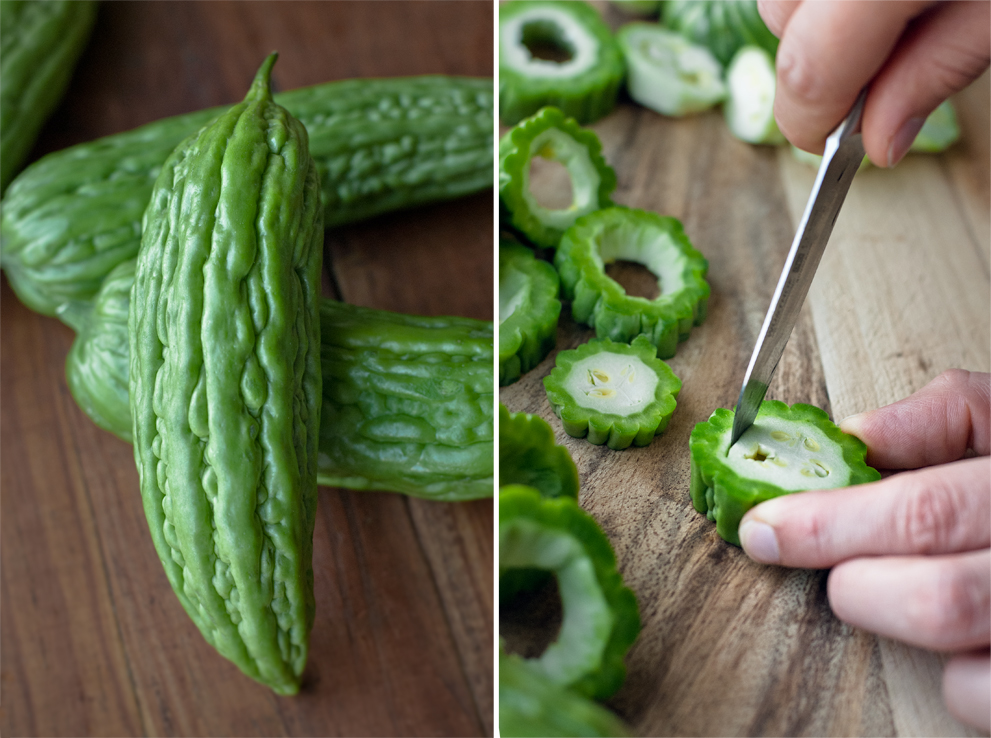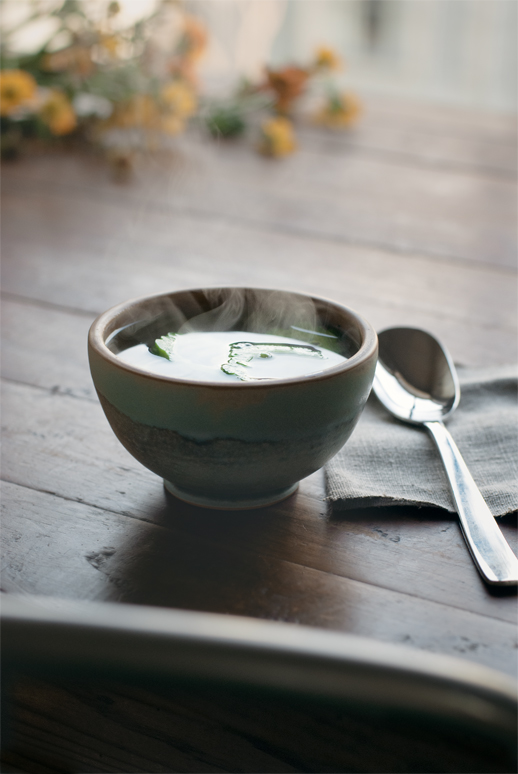
Do you remember certain dishes from childhood that you can never get enough of? Born into a foodie family, I have many such memories, but there’s one particular dish that stands out: a humble soup made with stuffed bitter gourd and pickled mustard greens. It is not a very pretty-looking dish. In fact, everything about it looks a deep greenish-grey, but the flavours are so delicate and complex, there’s nothing else quite like it.
It’s hard to talk about food without alluding to where I was born. The flavours I grew up with are a unique mix brought by the ethnic Chinese who immigrated to Nanyang—south of the ocean—then evolved with local Malay and Indian cuisine. The bitter gourd is a strange vegetable, and the taste for it is definitely acquired: its bitterness is not for the faint-hearted. The Hokkien folk would typically slice it thin and flash-fry it with plenty of oil, garlic and egg, maybe a hint of soy sauce, and serve this up as a non-meat fare. The immigrant Chinese to South East Asia took the language of food seriously: to be able to “eat bitterness” means being able to withstand hardship, and as a child, this is considered an essential lesson you must learn, growing up in a foreign land.
I have spent nearly two thirds of my life away from my childhood home. Once a foreigner, always a foreigner. One day, in the depths of a snowy Canadian winter, I wondered how hard it would be to recreate this soup. In some ways, I think you have to live away from the food you grew up with to truly appreciate it. So, I called my mother, who not only is an excellent cook, but also possesses an amazing memory. Problem was, she tended to recount recipes almost as if she was recalling poems. She would pack a lot of steps in a couple of sentences, so it often took time to decipher any dish. Eventually, I got over the fear of not trying, and set about recreating one of the most distinctive tastes I remembered and loved.
First, I had to see if I could acquire the ingredients. Bitter gourd and mustard greens are often available in Asian supermarkets, so my first stop was Chinatown. If you have never seen it before—though it’s more likely that you’ve seen it and not known the name—the bitter gourd is that funny, crinkly-looking melon that looks as if someone has taken a cucumber, bleached it slightly and blown bubbles into its skin. Mustard greens can be a little harder to identify because they are often sold when young as well as when they have grown more mature. For pickling, we want the mature version that looks more cabbagey, with big fat stems. If you’re still not sure, the Chinese label looks like this: 芥 菜. While you’re there, pick up some dried shrimp, we’ll need it later.
Now, it’s entirely possible to buy imported, pickled mustard greens. But every single packet I’ve picked up contains food colouring, and I don’t understand why we can’t accept pickles for the colour they are, so I’ve set about making my own.
A clever pickle
My mother’s minimalist instructions were: “Buy the mustard greens, cut them up into small pieces, and stick them in a jar with salt water. If you want it to be slightly sour, use the water from washing rice.”
How much salt? The first time I made this pickle I used a saturated salt solution: I boiled some water and stirred in as much salt as it would hold. This is, of course, technically brine. I took one of my airtight jars, rinsed it thoroughly in freshly boiled hot water, piled in the coarsely chopped mustard greens and filled it up with the salt solution, making sure the water covered the greens completely. Then I waited about a week. I actually liked it much better after about three weeks. By that time, the vegetables have started to turn somewhat grey, several shades away from its former bright green glory, but it was perfectly tasty: salty and just a spicy hint of mustard.
Much later on, I found another way to give this humble pickle a little more zing. After boiling about two cups of water, a good amount of salt, a bit of sugar and a quarter cup rice vinegar together, I’d pour it over the mustard greens tucked into the pickling jar. The heat gives it a nice seal.
In an age of instant gratification, it is strangely satisfying to be made to wait, because a pickle just needs to take the time it takes.
There’s something immensely rewarding about making pickles. In an age of instant gratification, it is strangely satisfying to be made to wait, because a pickle just needs to take the time it takes.
A fishy secret
The stuffing for the bitter gourd is a combination of minced pork and fish paste, which gives the stuffing its zeal. Fish paste? It sounds exactly like what it is: fish meat mashed into a paste. I had no idea where to find this, but it occurred to me that I could learn to make it, so it was another phone call to Mother.
Apparently, mackerel works best. Having made my own fish paste now on two different continents, it seems fairly easy to acquire, and most of all: cheap. Mother said, “You can slice off the head and remove the main bones and keep it for a soup.” I’m too squeamish for this, so I asked the poissonière to fillet the fish for me.
Once at home, I mixed some salt with hot water. Roughly three tablespoons of hot water can hold one teaspoon of salt. While letting the water cool to room temperature, I scraped the meat off the fillets with a spoon. Then, dribbling a bit of salt water over the fish, I tenderised it with the back edge of my cook’s knife. This is a very repetitive thing to do: I’d knock the back of the knife several times all over the fish, spooned more salt water over it, used the sharp edge of the knife to fold the fish over itself, then more knocking, more salt water, fold, et cetera.
When the fish starts to look more like paste than fish, you’re done. It always takes less time than it appears. I would usually pop it into the freezer in a clean Ziploc; it is surprisingly compact and freezes well. This is because I can never seem to acquire fresh mackerel and healthy-looking bitter gourd at the same time. I’ve taken to preparing the fish paste whenever I can get hold of mackerel, so when it comes time to make the stuffing, it’s a matter of allowing the fish paste to defrost overnight.
Cooking day
Prepare the stuffing
Mother said, “For the stuffing, use one part fish paste to four parts minced pork. Make sure it’s not too lean, or it won’t be nice. Fry dried shrimp and shallots. Season the pork the normal way, mix everything together. Stuff the gourds and panfry both sides.”
To season the “normal way” is to use one of my mother’s seasoning mixes that works for just about everything: light soy sauce, salt, pepper (white is best, if you can get it), a generous pinch of corn flour, and a touch of sugar. It’s difficult to describe the proportions, but it’s somewhere between enough to flavour it but not enough to drown it. Whisk it together first or stir it straight into the meat, it doesn’t really matter, but I would let the meat sit for at least an hour before mixing it with everything else.
As for the dried shrimp, I soaked them in hot water for a couple of hours ahead of time to soften them and to remove some of the saltiness. Once drained, I pounded the shrimp with a pestle and mortar until they flaked and became almost fluffy.
I shook a generous glug of canola or sunflower oil into a frying pan and turned up the heat. Use a wok if you fancy, but a frying pan is just fine. Olive oil wouldn’t do as it would start to smoke at a temperature too low for what I needed. I then tossed in some finely chopped shallots and softened them. Into the frying pan went the shrimp. Now might be a good time to open a window or turn on the cooker hood. It’s not easy to tell when the shrimp is cooked enough, so I tend to trust my nose. Generally the shrimp and the shallots will look much the same when cooked that you can’t tell one from the other: a delicious, fragrant, golden mess. I set it aside and let it cool a little.
I mixed the minced pork, already seasoned, with the fish paste, followed by the shallots and shrimp. Now for the actual stuffing!
Fill it up
After rinsing the gourd (skin and all) under cold water, I sliced it into pieces about an inch thick. Using the back tip of a teaspoon, I gently cored out the white, fluffy insides, as well as any seeds, so that I was left with green rings of gourd. It’s important not to damage the structure of each ring as you go, otherwise it would be difficult to fill later.
It’s important not to damage the structure of each ring as you go, otherwise it would be difficult to fill later.
Then, the dirty work. Picking up a rough ball of stuffing with clean fingers, I pushed it into a gourd ring. By pressing both palms together on either side of the stuffed gourd in the middle of my hands, I was able to make the stuffing sit evenly in the gourd ring and ensure that it was nicely compact. After all the gourd slices were filled, I coated both sides of each slice with flour. Then I lightly fried them in the pan, tapping off any excess flour beforehand so it would smoke less. It helps the stuffing stay stuffed, if you get my meaning.
A whole world in a soup

And then, finally, the stuffed bitter gourd slices and a generous handful of pickled mustard greens go into a pot of water, brought to the boil, and lowered to a simmer for some time. How much water? For how long? Mother didn’t tell me, and I forgot to ask. It seemed logical that there needed to be enough water to cover everything and a little more, so that was what I did. As for how long? When the bitter gourd slices are thoroughly cooked through, the gourd rings turn a deep grey-green, not unlike the pickles. The mustard greens get to a point where they melt in your mouth in a soft, hot explosion.
I like to imagine that all the colour must have disappeared into making the soup taste so good: the earthiness of the shallots, the salt of the shrimp, the sweet-richness of the pork, the sea-tinged freshness of the fish mingled with a deep-green bitterness of the gourd, all lifted with a slight, tangy sourness from the pickled mustard greens. Never mind that it looks mostly grey, never mind at all.
At this point, I would typically distract myself from the wait and mix some fresh chopped chilli or some sambal oelek, a splash of soy sauce and a small pinch of sugar in a little bowl. A little spice works very well with the stuffed bitter gourd.
Then I would wait an hour, or two, or a little more. You know the point when a good soup starts to taste divine? That’s how long it takes.